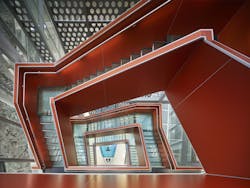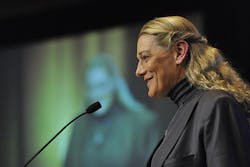In the ongoing rise of net zero energy buildings – where the total amount of energy consumed annually by a building is equal to the amount of renewable energy it can generate – our cover story this month chronicles a true milestone in the sustainability movement.
Located in downtown Silver Spring MD, United Therapeutics’ new, 210,000-sq-ft Unisphere biotech research and development facility opened last fall as the largest, site-powered, commercial net zero building in the US. In February, it earned a LEED Platinum rating from USGBC. For all that, we congratulate the owner, as well as the building team: EwingCole (A/E); Whiting-Turner (GC); Schneider Electric (BAS controls manager); and Hush Studios (interactive displays designer).
As our story notes, though, the building clearly would not have achieved it ambitious goals—or its place in history—had its owner blinked.
But Martine Rothblatt did not blink. Instead, when faced with antiquated municipal regulations that would have forced the building’s innovative geo-exchange wells to be located outside Unisphere’s footprint, the United Therapeutics CEO refused to take the path of least resistance. She insisted that the building team had to find a way to meet her net zero energy mandate. Or else she would cancel the project.
“We were all stunned,” United Therapeutics’ Tom Kaufman told HPAC. “She explained that part of the reason why we’re developing this building is to inspire others to push beyond the loop of sustainability. And if you can’t locate geo-exchange wells within the footprint of a building, then no future developer or owner will ever be able to achieve a net-zero building in an urban environment.”
When was the last time we heard an owner say something like that?
In the end, with lobbyist help, United Therapeutics eventually was able to change the regulations to keep the project on track to meet its unprecedented goals.
Still, as rare as Unisphere’s achievement may be now, more owners seem to be getting onboard. In fact, there is a growing “net zero energy surge,” as we reported in March, and which was confirmed again last month with the release of the latest New Buildings Institute (NBI) database of low-energy projects across the United States and Canada.
NBI’s official 2019 count is 580 certified, verified, and emerging projects, according to its 2019 Getting to Zero Project List that NBI released in May. That is a 10-fold increase since NBI started tracking buildings in 2012. Growth in the count is confirmed by reported plans to invest in zero energy buildings in the next decade, according to Johnson Controls’ 2018 Energy Efficiency Indicator Study. JCI VP Clay Nesler noted, “61% of U.S. respondents are very or extremely likely to have one or more facilities that are nearly zero, net zero, or positive energy or carbon status within the next 10 years.”
“That is an amazingly high number considering if we had asked this question only four years ago, we probably would have been in the single digits,” Nesler added.
How have you been adapting to this growing trend? The next ‘smart’ developer you talk to may want to know.
About the Author
Rob McManamy
Editor in Chief
An industry reporter and editor since 1987, McManamy joined HPAC Engineering in September 2017, after three years with BuiltWorlds.com, a Chicago-based media startup focused on tech innovation in the built environment. He has been covering design and construction issues for more than 30 years, having started at Engineering News-Record (ENR) in New York, before becoming its Midwest Bureau Chief in 1990. In 1998, McManamy was named Editor-in-Chief of Design-Build magazine, where he served for four years. He subsequently worked as an editor and freelance writer for Building Design + Construction and Public Works magazines.
A native of Bronx, NY, he is a graduate of both the University of Virginia, and The John Marshall Law School in Chicago.
Contact him at [email protected].


